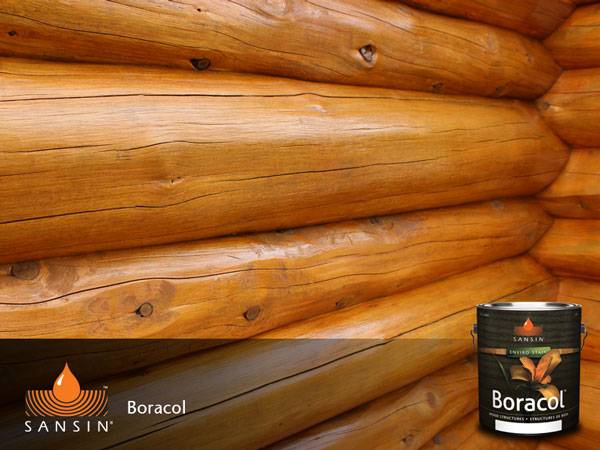By Sjoerd Bos, Managing Director at Sansin
Wood is an incredibly strong building material, but it must be protected properly to stand the test of time, and that means protecting it against wood-destroying fungi, insects and mold. Sansin Boracol 20-2 is designed to do just that - fight fungi and insect infestation. It is recommended for use on roof, floor or structural timbers, joinery, joist ends, and door and window framing. Boracol 20-2 penetrates wood exceptionally well – even heartwood, up to 3-5mm deep. It establishes a reserve from where further penetration takes place (up to 40 mm over two years in dry wood).
Because Boracol diffuses with moisture, it migrates into areas with higher moisture content. Boracol can also be used to eradicate wood rot in existing structures, and it can also be used to protect new and existing logs and timbers against fungi and wood-boring insect. In addition to organic surfaces such as wood, Boracol works to prevent mold on inorganic materials like stone or concrete. Sansin Boracol contains boron, which is far less hazardous than traditional treatments and will give your project the lasting protection it needs – with low toxicity.
The Science Behind Boracol
Premature decay of untreated wood that was periodically or permanently exposed to increased moisture content (over 25%) reached serious proportions in North America in the mid-2000s. As a result, requirements for reliable treatments were introduced. Boron-based wood preservatives were found to be the most acceptable pre- and remedial treatment for rot and insect attack.
In addition to their proven efficiency, the borate formulations are widely accepted as environmentally safe wood preservatives, having very low toxicity. Boracol wood preservatives are based on inorganic Boron (disodium octaborate tetrahydrate), which not only has the ability to diffuse in moist wood but also contains a very low vapor pressure and has the ability to progressively penetrate the wood even several years after application. Over this time, because of the boron concentration in the wood, the degrading organisms have no chance to survive and cause damage.
The only condition for proper performance is that the treated wood should not be exposed to direct contact with water (i.e. wood-in-ground contact or occasional heavy rain over construction wood). If the wood is exposed to water in this way, it is possible the Boron will “travel the opposite way” by a leaching process. To keep this from happening, a post-treatment application of the wood surfaces is recommended by applying a proven wood protection system like Sansin SDF, DEC or Classic 1-2-3.
How to Apply Boracol
Boracol can be applied by brushing, dipping or spraying. Within the first 24 to 48 hours, the product will penetrate 3-5 mm deep into the wood and will establish a reserve of over-concentrated Boron from which further penetration and diffusion will take place depending on the wood’s moisture content.
Brush Application: This method requires some shear force to be applied in order to evenly spread the product over a range of different surface profiles. The brushing method yields best results if applied before wood components are assembled.
Dipping: This method requires a non-corrosive dipping tank and an additional support surface inclined at an angle to allow excess product to drain off into the tank. The advantage of this method is that all the surfaces – including splits and cracks – are fully treated.
Spraying: Different spray applicators can be used, and the viscosity of the product can be adapted by adding up to 5% water.
Injection Method: This method is used to increase the quantity of Boron in wood locations where condensed water may be trapped for a longer period. A syringe-type injector can be used to fill cracks and gaps or pre-drilled holes.
It is advised to clean the wood before treatment. Vacuum cleaning, power washing or compressed air are good ways to remove dirt. Boracol forms a wet-appearing film on wood surfaces as soon as the product is applied. The film will stay on wood for a period necessary for the solvent to penetrate the wood surface, bringing the Boron compound deeper in the wood. During this time, the treated wood surfaces should be protected from contact with water.
If the treated wood is intended for subsequent paint or stain application, allow at least seven days for Boracol to completely penetrate and disappear from the surface. If a slight film or crystal-like particles are visible, the surface should be wiped off with a damp cloth. Light sanding can be very helpful to remove boron crystals and improve adhesion of the coating. Subsequent coating is particularly important when wood is exposed to contact with rain or con-densed water that stays trapped in the wood for a longer period of time (e.g. balconies). To learn more about Sansin Boracol 20-2, click here.


No comments:
Post a Comment